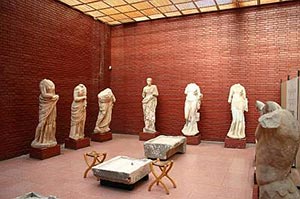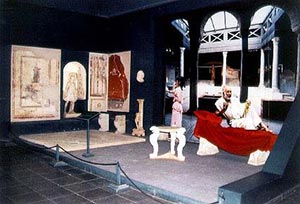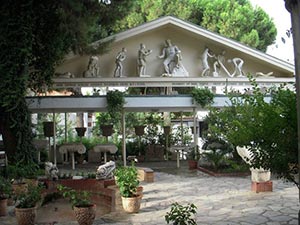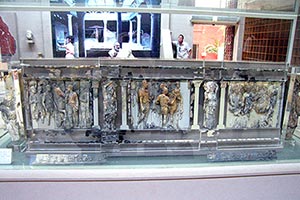The Ancient City of Ephesus and the Archeological Museum
 Ephesus Selcuk, the Museum of Ephesus The Ancient City of Ephesus and the Museum
Ephesus Selcuk, the Museum of Ephesus The Ancient City of Ephesus and the Museum
Information, about Ephesus Museum, Selcuk Ephesus Museum information, historical places Ephesus Selcuk Museum. Ephesus Museum, Ancient City Ephesus Museum
Up to the year 1906, numerous recovered objects of high quality were removed to Vienna, objects which can be seen today at the Ephesus Museum, an annex to the Collection of Greek and Roman Antiquities. The highlights include the Parthian Monument, the Amazon from the Altar of the Artemision, the bronze Athlete statue and the Child with a Goose. Alongside the Ephesian artefacts, the museum is also home to architectural specimens and sculptures from the Sanctuary of the Great Gods of the Mystery cult on the Greek island of Samothrace, which was explored by Austrian archaeologists in 1873 and 1875.
Ephesus Museum, Ephesus Selcuk Museum, Ephesus Museum, Ancient City Ephesus Museum, In the beginning, in 1929, artifacts from diggings and the surroundin
 g were brought here and stored. In 1964, what is now the museum's southern section was built and artifacts were displayed there. The room was not big enough for the increasing number of artifacts so, in 1995 another section was added and used for exhibition. The Seljuk
(Selcuk)-Ephesus Museum is the most important and richest museum for possession and sole display of local artifacts. The Ephesus Museum is a rich and important museum for Ephesian and Anatolian archeology with artifacts from digs at Ephesus, St. John Church, the Belevi Mausoleum, and other local ruins. Including artifacts from the Mycenian, Archaic, and Turkish periods as well, the majority are from the Hellenistic, Roman, Byzantine periods.
g were brought here and stored. In 1964, what is now the museum's southern section was built and artifacts were displayed there. The room was not big enough for the increasing number of artifacts so, in 1995 another section was added and used for exhibition. The Seljuk
(Selcuk)-Ephesus Museum is the most important and richest museum for possession and sole display of local artifacts. The Ephesus Museum is a rich and important museum for Ephesian and Anatolian archeology with artifacts from digs at Ephesus, St. John Church, the Belevi Mausoleum, and other local ruins. Including artifacts from the Mycenian, Archaic, and Turkish periods as well, the majority are from the Hellenistic, Roman, Byzantine periods.Terrace Houses Room
Fountain Artifacts

Legend had it that John wrote his gospel in Ephesus at the request of other disciples, then died in the church named for him on Ayasoluk Hill. Later legends developed that he was not really dead, but sleeping, and dust could even be seen moving above his grave as he breathed.
The 13th-century Golden Legend narrates Johns death as follows.
Recent Findings Room
The Garden
 s from the 2nd century is decorated with quite interesting ornamentation. The figures on it resemble figures of
Moses. Judging by the inscription on its lid it was used again in the Byzantine period. Along the west wall of the garden there are grave and offering stones on display. The sundial in the center is in a half-moon shape.
s from the 2nd century is decorated with quite interesting ornamentation. The figures on it resemble figures of
Moses. Judging by the inscription on its lid it was used again in the Byzantine period. Along the west wall of the garden there are grave and offering stones on display. The sundial in the center is in a half-moon shape.
Artemis Room
Imperial Cult and Portrait Salon
 that temple. The altar in the center was a piece of the U-shaped altar of the temple to Domitian. There are friezes on three sides of it. Just before leaving the room there are pieces from the giant statue to Domitian. There are also pieces from statues of August and his wife, Livia in the room.
that temple. The altar in the center was a piece of the U-shaped altar of the temple to Domitian. There are friezes on three sides of it. Just before leaving the room there are pieces from the giant statue to Domitian. There are also pieces from statues of August and his wife, Livia in the room.VISITING HOURS
08.30 a.m - 18.30 p.m (Summer / April-October)
08.30 a.m - 17.00 p.m (Winter / Nov-March)
Entrance Fee : 10 TL p.p In the museum which is kept open all year round are displayed works most of which have been unearthed in the course of the excavations carried out in Ephesus and some which have been excavated in such ancient towns as Claros in the near vicinity. The Ephesus Museum is the most significant local museum of Turkey with the works it contains, the visitor capacity and cultural activities.
The Ephesus Museum is consisted of the following sections:
1- Hall of the Terrace Houses Findings
2- Hall of the Fountain Findings
3- Hall of the New and Small Findings
4- Great Courtyard

5- Hall of the Tomb Findings
6- Hall of Artemis Ephesia
7- Hall of the Imperial Cult
8- Small Courtyard
The museum is open 365 days a year.
THE MOST CREATIVE AND ECONOMICAL EPHESUS TOUR FOR YOU!
We provide you with the air conditioned vehicle with the driver and the licensed professional English speaking guide. You can draw up the program and determine the sights you wish to visit our guide and the private vehicle with the driver will be at your disposal. This kind of Ephesus tour is for those who is short of time or just have special wishes about what to visit around Kusadasi and Ephesus.